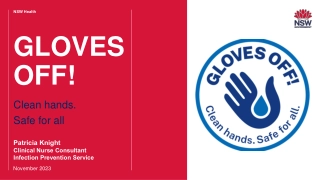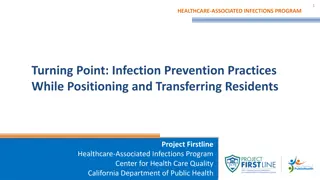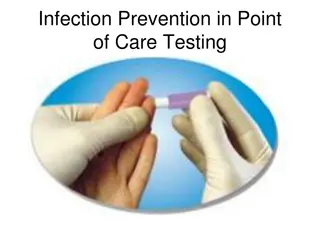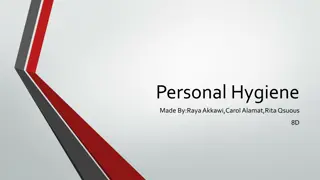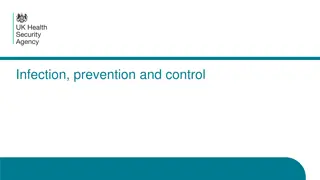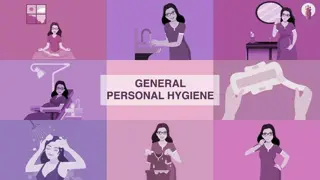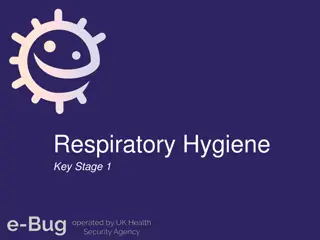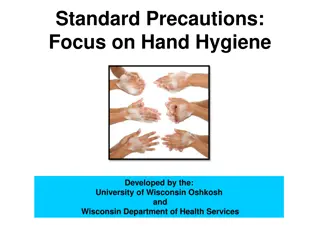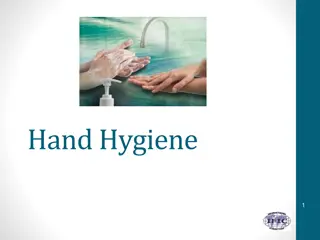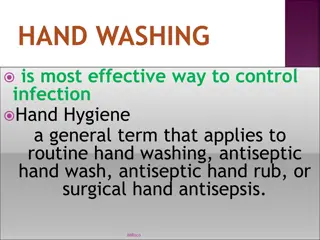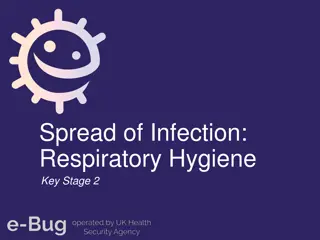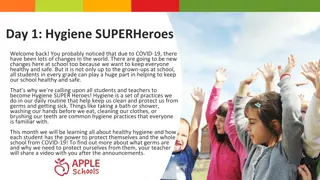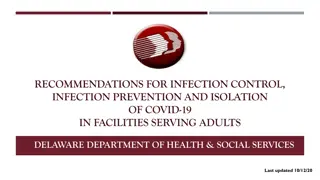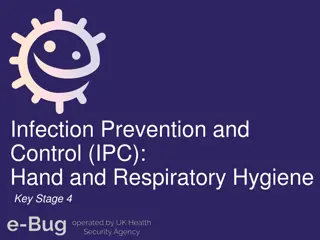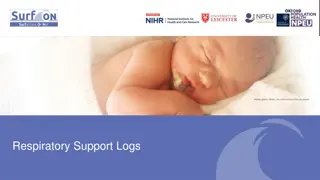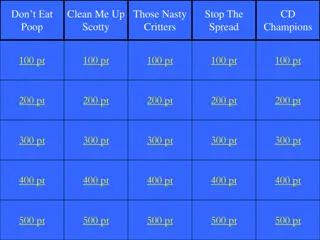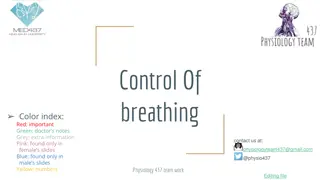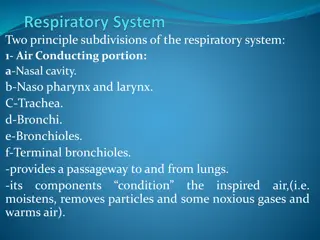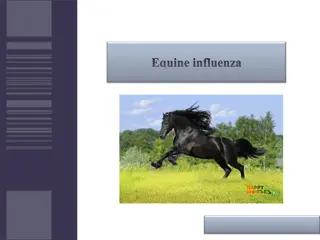Respiratory Hygiene for Infection Prevention
Diseases like colds and flu can be spread through sneezing and coughing, highlighting the importance of respiratory hygiene in preventing infections. This educational material covers key aspects of respiratory hygiene, learning outcomes, curriculum links, and a main activity involving a "Snot Gun" experiment to demonstrate how microbes spread. Discussions and points for further exploration are also provided to enhance understanding of infection transmission.
Download Presentation

Please find below an Image/Link to download the presentation.
The content on the website is provided AS IS for your information and personal use only. It may not be sold, licensed, or shared on other websites without obtaining consent from the author.If you encounter any issues during the download, it is possible that the publisher has removed the file from their server.
You are allowed to download the files provided on this website for personal or commercial use, subject to the condition that they are used lawfully. All files are the property of their respective owners.
The content on the website is provided AS IS for your information and personal use only. It may not be sold, licensed, or shared on other websites without obtaining consent from the author.
E N D
Presentation Transcript
Infection Prevention and Control (IPC): Respiratory Hygiene Key Stage 3
Learning Outcomes All students will: Understand that sometimes microbes can make us ill. Understand that prevention of infection, where possible, is better than cure. Understand not to spread their harmful microbes to others. Understand that infection can spread through sneezing and coughing. Understand that covering your mouth and nose with a tissue or your sleeve (not your hands) when you cough, or sneeze helps prevent the spread of infection. Most students will: Understand that coughing or sneezing in your hand can still spread infection. e-Bug.eu
Curriculum Links PHSE/RHSE Health and prevention Science Working scientifically Scientific attitudes Experimental skills and investigations English Reading Writing e-Bug.eu
How Microbes Spread When We Sneeze? Many diseases are airborne and spread in tiny droplets of water, which are coughed and sneezed into the air by people. Diseases that spread in this way range from viral diseases like colds and flu to rarer, more serious infections like meningitis or tuberculosis (TB) which are caused by bacteria and can result in death. Colds and flu are caused by a virus and not bacteria and, as such, cannot be cured by antibiotics. It is very important for everyone s health that people cover their mouth and nose when they cough and sneeze as this can reduce the spread of infection. e-Bug.eu
Main Activity: Snot Gun e-Bug.eu
4. Spray the bottle with hand of glove over nozzle 5. Spray the bottle with kitchen towel over the nozzle 1. Write your name on a sticky note and place on runway 2. Spray the bottle from the end of runway 3. Measure the distance e-Bug.eu
Discussion e-Bug.eu
Discussion Points Were you surprised by the results in the activity? What has this experiment taught you about the transmission of microbes? How many students would have been infected by a sneeze? Would there be a change in the results if the experiment was carried out outside on a windy day? e-Bug.eu
Extension Activities e-Bug.eu
Fascinating Fact Lower respiratory infections remain the world s most deadly communicable (infectious) disease, ranked as the 4th leading cause of death. In 2019 it claimed 2.6 million lives. e-Bug.eu
Snot Gun Experiment Questions 1.Which disk do you think will be most affected by the sneeze? ________________________________________________ 2.Which people do you think will be least affected by the sneeze? ________________________________________________ 3.What do you think will happen when you place a gloved hand over the sneeze? ________________________________________________ 4.What do you think will happen when you place a tissue over the sneeze? ________________________________________________ e-Bug.eu
Snot Gun Experiment Results 1.What was the furthest distance the sneeze travelled? Distance travelled Number of people contaminated Sneeze alone Gloved hand Tissue e-Bug.eu
Snot Gun Experiment 2. Did any of the sneezes contaminate any of the people on the side lines? If so, how many? Sneeze alone Gloved hand Tissue 3. How many microbes landed on the person behind the sneezer? __________________________________________________ __________________________________________________ e-Bug.eu
Snot Gun Experiment Conclusions 1.Based on this experiment what have you learnt about microbial transmission? ________________________________________________ 2.If we don t wash our hands after sneezing into them, what might happen? ________________________________________________ 3.Which method is best for preventing the spread of infection, sneezing into your hand or sneezing into a tissue? Why? ________________________________________________ e-Bug.eu
Snot Gun Experiment - Answers Questions 1.Which disk do you think will be most affected by the sneeze? ________________________________________________ The paper disks directly in front of and to the sides of the sneezer will be the most affected. 2.Which people do you think will be least affected by the sneeze? ________________________________________________ The person behind the sneezer and those furthest away. 3.What do you think will happen when you place a gloved hand over the sneeze? ________________________________________________ The sneeze will not travel to as many people but the microbes will be found on the hand. 4.What do you think will happen when you place a tissue over the sneeze? ________________________________________________ All the microbes will be trapped in the tissue. e-Bug.eu
Snot Gun Experiment - Answers Results 1.What was the furthest distance the sneeze travelled? Distance travelled Number of people contaminated Sneeze alone This will vary depending on the type of spray bottle used, but in general the sneeze alone will infect more people and travel the furthest. The sneeze in the tissue should affect the least. Gloved hand Tissue e-Bug.eu
Snot Gun Experiment - Answers 2. Did any of the sneezes contaminate any of the people on the side lines? If so, how many? Sneeze alone This will vary depending on the type of spray bottle used, but in general the sneeze alone will infect more people and furthest. The sneeze in the tissue should affect the least. Gloved hand travel the Tissue 3. How many microbes landed on the person behind the sneezer? __________________________________________________ __________________________________________________ Your results from experiment in class. e-Bug.eu
Snot Gun Experiment - Answers Conclusions 1.Based on this experiment what have you learnt about microbial transmission? ________________________________________________ Microbes can pass very easily from person to person through sneezing and touch. 2.If we don t wash our hands after sneezing into them, what might happen? ________________________________________________ We can still transfer the harmful microbes found in a sneeze to other people when we touch them. 3.Which method is best for preventing the spread of infection, sneezing into your hand or sneezing into a tissue? Why? ________________________________________________ Sneezing into a tissue; this causes the microbes to get trapped and we can then throw the tissue away. e-Bug.eu
Spread of Infection on a Cruise Discussion Imagine that you are on a Mediterranean cruise that will call at ports in Spain, France, Italy, Malta and Greece. At each port-of-call passengers can get off for shore excursions. On the cruise there are: a. A family of 4 on their way back to Australia. b. 12 passengers planning an onward journey from Greece to Turkey. c. 4 passengers planning an interrailing excursion through Hungary, Czech Republic and Germany. d. The remaining passengers plan to return to the USA On this cruise one man has a new strain of the influenza virus and it is very contagious. a. Hypothesise and consider how many people will he infect and how far will this virus travel in 24 hours, and in 1 week? b. What could have been done to prevent the infection travelling so far? e-Bug.eu
Respiratory Hygiene Best Practice Three school friends, Sara, Elisa and Chloe, have all caught a cold and are coughing a lot. As you can see from the picture below, each student has adopted a different way of covering their coughs and sneezes. One is sneezing into a tissue, one into their elbow, and one on their hand. Discuss the advantages and disadvantages of each method in the context of: a. Their daily life b. Reducing the spread of infection. e-Bug.eu
Cover your coughs and sneezes Respiratory Hygiene Poster 1 Use a tissue if you have one If you have no tissue use your sleeve Wash your hands for 20 seconds with soap and water. To help keep time - sing Happy Birthday twice 2 e-Bug.eu
Respiratory Hygiene Quiz After we sneeze into our hands, we should: (2 points) How can you spread microbes to others? (3 points) Wash our hands Dry our hands on our clothes Take antibiotics None of the above is necessary Touching Sleeping Sneezing Coughing e-Bug.eu
Respiratory Hygiene Quiz The best way to stop microbes from spreading is: (2 points) If you do not have a tissue available, the next best option is to sneeze: (1 point) To use your hand to cover your sneeze To use a tissue to cover your sneeze To use a sleeve if you haven t got a tissue To drink plenty of fluids Into your hands Into your sleeve Into an empty space Onto your desk e-Bug.eu
Respiratory Hygiene Quiz What should you do with a tissue after sneezing into it? (1 point) What might happen if we don t wash our hands after sneezing into them? (1 point) Put it in your pocket for next time Put it straight in the bin Put it up your sleeve for next time Any of the above Nothing Transfer harmful microbes to other people Help protect our microbes e-Bug.eu
Respiratory Hygiene Quiz - Answers After we sneeze into our hands, we should: (1 point) How can you spread microbes to others? (3 points) Wash our hands Dry our hands on our clothes Take antibiotics None of the above is necessary Touching Sleeping Sneezing Coughing e-Bug.eu
Respiratory Hygiene Quiz - Answers The best way to stop microbes from spreading is: (2 points) If you do not have a tissue available, the next best option is to sneeze: (1 point) To use your hand to cover your sneeze To use a tissue to cover your sneeze To use a sleeve if you haven t got a tissue To drink plenty of fluids Into your hands Into your sleeve Into an empty space Onto your desk e-Bug.eu
Respiratory Hygiene Quiz - Answers What should you do with a tissue after sneezing into it? (1 point) What might happen if we don t wash our hands after sneezing into them? (1 point) Put it in your pocket for next time Put it straight in the bin Put it up your sleeve for next time Any of the above Nothing Transfer harmful microbes to other people Help protect our microbes e-Bug.eu
Learning Consolidation e-Bug.eu
Create Some Simple Rules or Messages to Reduce the Spread of Coughs, Colds and Flu in Your School. Coughs and sneezes spread diseases; Catch it, bin it, kill it; Cover my coughs and sneezes with a tissue or cough/sneeze into the crook of my elbow or sleeve (not my hand); Wash my hands after a cough or a sneeze or use hand sanitiser. e-Bug.eu
Germ Defence The website germdefence.org can be used as a tool to help you reduce the likelihood of getting colds, flu and stomach upsets, and from transmitting them on to other people. You can follow simple steps and can print or download a summary of the information you have reviewed. e-Bug.eu


